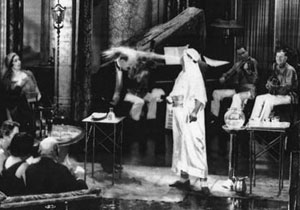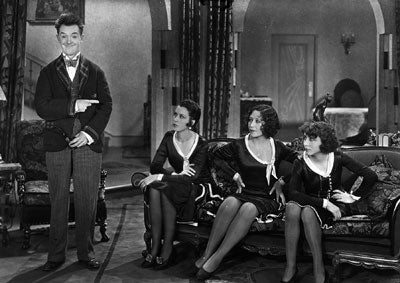Left: A publicity photo for Blotto and the Spanish and French versions. Stan Laurel is shown with Anita Garvin, who played his wife in Blotto, Linda Loredo from La Vida Nocturna, and Georgette Rhodes from Une Nuite Extravagante.
By Randy Skretvedt
On March 27, 2011, UCLA Film & Television Archive will present two rare Laurel and Hardy featurettes. La Vida Nocturna (1930) is the Spanish-language equivalent of the team’s short Blotto (1930), while Politiquerias (1930) is a greatly amplified version of Chickens Come Home (1930). The team had become wildly popular all over the world during the silent era, and after the introduction of sound, producer Hal Roach sought to retain Laurel and Hardy’s enormous worldwide audience by making companion versions of their new films in Spanish, French, German and Italian. Ten of the team’s releases were given the multilingual treatment between October 1929 and February 1931. Since Stan and Babe only spoke English, interpreters would write their dialogue phonetically on a blackboard just out of camera range.
These films were tremendously popular—in fact, too popular to suit Hal Roach’s distributor, as he told me in 1980:
“Those foreign pictures were extremely successful; the prices we got in South American countries and Spain were fantastic. But finally, Metro-Goldwyn-Mayer made us quit, because the other countries immediately said, ‘We don’t want dubbed pictures from Metro; we get them not dubbed from Hal Roach.’ They wanted Garbo and Gable and everybody else to speak German. Well, hell, that was all right as far as comedy was concerned; if Laurel and Hardy spoke lousy, it didn’t make any difference, you know? But you could imagine with these other people, like Gable, trying to speak German, and saying just yes or no—it would be impossible. So, I stopped—because the Metro people were one hundred percent right.”
In addition to the novelty of hearing Laurel and Hardy speak Spanish (Hardy’s is quite good, while Laurel never quite overcomes his Lancashire accent), these films have entirely new sequences. Longer pictures meant higher rental fees, and the team’s popularity was such in Spanish-speaking countries that their short films were often billed over the feature attraction. As a result, some of the two- and three-reel domestic films were lengthened to four or five reels.
La Vida Nocturna
La Vida Nocturna (“The Night Life”) has the original 1930 underscoring which is no longer heard on domestic prints of Blotto, all of which now derive from a 1937 reissue which had an updated score. Stan’s wife is not played by Anita Garvin, but instead by Linda Loredo, a vivacious actress who also portrayed Mrs. Laurel in the team’s 1931 short Come Clean. Sadly, she died at 24 in August 1931.
La Vida Nocturna follows the basic story line of Blotto: during Prohibition, Ollie persuades Stan to swipe his domineering wife’s one precious bottle of liquor so the boys can sneak away and drink it up at the opening of the Rainbow Club; Mrs. Laurel is aware of the plot, however, and replaces the booze with cold tea, mixed with an unappetizing variety of spices and additives. Determined to have a high old time, the boys manage to get “drunk” anyway, if only through some form of self-hypnosis.
"Longer pictures meant higher rental fees, and the team’s popularity was such in Spanish-speaking countries that their short films were often billed over the feature attraction."
Most of the new scenes take place during the nightclub floor show; the Latin girl dancer has a much longer routine here (accompanied by different music), and she’s followed by a raggedly-clad comedy relief “balloon dancer,” whose attempts at enticing the audience are undermined by the balloons which keep breaking. A new gag involves an errant bottle of seltzer which sprays onto a chair, which is then sat upon by an unsuspecting dowager. The sequence in which the boys grow misty-eyed after a performance of “The Curse of an Aching Heart” is followed here by their own increasingly off-key performance, punctuated by percussive hiccups. The floor show concludes with a hoochy-coochy dancer whose gyrations, one suspects, might not have passed the American censors even during this Pre-Code era. The sequence in which the boys begin to laugh uproariously at their own cleverness was entirely re-shot to include Linda Loredo in the background, and is just as convincing as it is in the English-language version, showing that Laurel and Hardy were truly remarkable actors in any language.
Politiquerias
Politiquerias, based on Chickens Come Home, is almost twice the length of the three-reel original and has more additional footage than any of the foreign-language pictures which have surfaced to date. Most of these new scenes do not involve Laurel and Hardy, but they are precious, fascinating and wildly entertaining nonetheless. The basic story line has Hardy (in business with Stan as “Dealers in High Grade Fertilizer”) running for Mayor. His campaign is compromised by the return of an old flame (played in the English-language version by Mae Busch, and here by Rina De Liguoro—who was actually from Italy and remained active in that country’s film industry through 1963). The former girlfriend has a photograph which she’ll use to incriminate Hardy as an adulterer unless she’s paid off; Stan is sent to her apartment to keep her at bay while the Hardys entertain a number of prominent and influential guests.
As with La Vida Nocturna, most of the new footage gives the spotlight to other entertainers whose contributions have little to do with the plot. Nevertheless, it’s wonderful to have the magic act of Abraham J. Cantu preserved on film—with the extra added attraction of James Finlayson, playing the Hardys’ butler, squinting and fuming when Cantu calls upon him to participate in various shenanigans involving cards, silks and lots of eggs.

Good as Cantu is, nothing can surpass the truly unforgettable performance of Hadji Ali, a professional regurgitator. His ability to swallow massive amounts of water and hazelnuts and bring them up at will is nothing short of astonishing. Born in Egypt in 1892, Hadji Ali was renowned in vaudeville all over the world; reportedly, he was appearing in a stage prologue before the film Moroccoat Grauman’s Chinese Theater when someone from the Roach studio saw him and invited him to appear in Politiquerias. He appears also in a 1934 Universal short in the Strange As It Seemsseries, and has a tiny bit in the 1932 Douglas Fairbanks, Jr. feature Scarlet Dawn, but Politiquerias is the only filmed record of his act—a priceless souvenir of the heyday of vaudeville. Hadji Ali died on November 5, 1937 in Wolverhampton, England, only 44 years old; he died not of a stomach ailment as one might suspect, but of bronchitis.
Domestic and International Versions
One might think that the foreign-language films were made concurrently with the domestic versions, but generally the procedure was to finish the English-language version before embarking on the Spanish, French, German or Italian versions. The reason for this was that Laurel and Hardy generally discarded about half of what was in the written script, replacing this with better material that was worked out on the set. Hal Roach always held the philosophy that “Fifty percent will not play”—in other words, about half of the written script might seem funny on paper, but doesn’t work once it’s actually acted out on the set. Stan Laurel and indispensable gag man Charley Rogers would usually come up with the new ideas, but anyone in the cast and crew was welcome to provide suggestions.
Production on the foreign-language films usually began once the domestic version had been finalized. As a result, Blotto was filmed between December 11 and 31 of 1929, but La Vida Nocturna and the French version, Une Nuit Extravagante, were made between January 2 through 17, 1930. Chickens Come Home was filmed between December 30, 1930 and January 10, 1931; Politiquerias was shot between January 12 and 23, 1931.
While the domestic Laurel and Hardy films were printed and re-printed until the original negatives were exhausted, the Spanish language materials were in pristine condition when they were rediscovered in 1986. It’s a joy to see Laurel and Hardy in crisp, clear, unblemished 35mm prints. The stunning quality gives the team’s comedy an immediacy which transcends the barriers of time and language; seeing these films provides confirmation that their artistry is ageless.
Randy Skretvedt is the author of Laurel and Hardy: The Magic Behind the Movies, a book which details the production of each of the team's films through interviews with more than sixty of the participants, unfilmed sequences from scripts, and other studio files. First published in 1987, it was revised in 1994 and 1996; a revised and expanded version is in preparation.






 Mobile Navigation
Mobile Navigation

